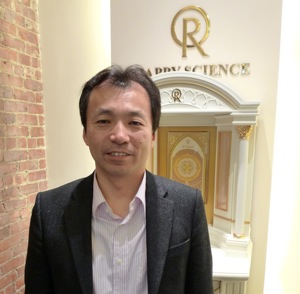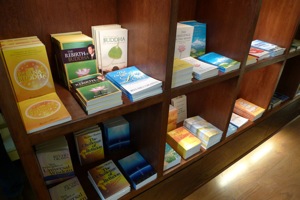Inside Happy Science
In June, I wrote a bit about Happy Science, intrigued enough by the Franklin Street storefront to poke around the group’s website. A couple of months ago, Happy Science’s PR rep invited me to act like a real journalist and take a meeting with Happy Science USA CEO Yuki Oikawa. Our first attempt misfired when I showed up only to learn that Oikawa had taken an earlier-than-expected flight to Chicago, to avoid getting stuck in town by a storm. This past Tuesday, we tried again.
 Wearing a sport coat and sneakers, the highly affable Oikawa (right) invited me inside. Born in Japan, he had lived in New York years ago, working for Merrill Lynch. Then he moved to London to work for a British company, which was where he joined Happy Science first as a member, and then on staff. Now he’s CEO, overseeing North American operations—temples in New York, L.A., and San Francisco, with one coming soon to Toronto, and offices (with meditation rooms but not prayer rooms) in Toronto, Chicago, Hawaii (2), Atlanta, Tampa, San Diego, and soon, Vancouver.
Wearing a sport coat and sneakers, the highly affable Oikawa (right) invited me inside. Born in Japan, he had lived in New York years ago, working for Merrill Lynch. Then he moved to London to work for a British company, which was where he joined Happy Science first as a member, and then on staff. Now he’s CEO, overseeing North American operations—temples in New York, L.A., and San Francisco, with one coming soon to Toronto, and offices (with meditation rooms but not prayer rooms) in Toronto, Chicago, Hawaii (2), Atlanta, Tampa, San Diego, and soon, Vancouver.
Happy Science, which Oikawa classifies as a “new spiritual movement,” claims more than 10 million members worldwide. Most are in Japan, where Oikawa says it’s “more like a social movement.” Happy Science had a publishing company there—the movement’s founder, Ryuho Okawa has written more than 500 books—and an opinion magazine called The Liberty. Last year, the organization established a political party, the Happiness Realization Party, and it’s about to open a middle school and has plans to found a university. Happy Science also makes animated films.
The New York temple opened its doors in September, 2008. Oikawa says they had been looking all over Manhattan, and when it came time to choose between locations in Midtown, Union Square, and Tribeca, Tribeca won because founder Okawa had also once worked on Wall Street. Happy Science bought and renovated the building—which had been home to a law office and an apartment—with donations from members. The New York temple has 500 members, 60 percent of whom are Japanese, and many of whom live in New Jersey. Membership donations are all voluntary.

 Upstairs are offices and accommodations—ten people can sleep there if they’re sharing rooms. Oikawa is actually living there while closing on an apartment; his wife will then join him from from Tokyo. On the ground floor is an elegant lounge with a pair of loveseats and bookshelves stocked with many titles by Master Ryuho Okawa. (Not all 500-plus of his books have been translated into English.) There are stairs both in the front of the building and in the rear; in the basement is another lounge (where members hang out, have coffee, and talk, and students do their studying). Past that lounge is meditation room (above), a carpeted but otherwise spare space. “Anyone can try meditation here,” said Oikawa. Ministers—there are four on the New York staff, including Okawa—lead the sessions.
Upstairs are offices and accommodations—ten people can sleep there if they’re sharing rooms. Oikawa is actually living there while closing on an apartment; his wife will then join him from from Tokyo. On the ground floor is an elegant lounge with a pair of loveseats and bookshelves stocked with many titles by Master Ryuho Okawa. (Not all 500-plus of his books have been translated into English.) There are stairs both in the front of the building and in the rear; in the basement is another lounge (where members hang out, have coffee, and talk, and students do their studying). Past that lounge is meditation room (above), a carpeted but otherwise spare space. “Anyone can try meditation here,” said Oikawa. Ministers—there are four on the New York staff, including Okawa—lead the sessions.
 We walked up the back stairs, where doors lead to the prayer room (right). It’s much more ornate than the meditation room, with seafoam-green walls and gold molding. The room’s focal point is a tiled nook, in which stands a gold statue of El Cantare—more on him in a minute—holding an apple (a symbol of New York City) and a staff. He’s flanked by a lectern and a donation box.
We walked up the back stairs, where doors lead to the prayer room (right). It’s much more ornate than the meditation room, with seafoam-green walls and gold molding. The room’s focal point is a tiled nook, in which stands a gold statue of El Cantare—more on him in a minute—holding an apple (a symbol of New York City) and a staff. He’s flanked by a lectern and a donation box.
In 1981, according to Okawa’s The Science of Happiness, the spirit of Jesus Christ visited Okawa, calling on him to be a global spiritual leader: “The following month, a hidden part of my consciousness—Shakyamuni Buddha himself—began to speak to me in a mixture of Japanese and Magadhi Prakit (an ancient Indian language) urging me to embrace my destiny and to spread the word of Buddha. He revealed to me that I am an incarnation of El Cantare…. El Cantare is the supreme consciousness of this planet Earth who has been guiding humankind from the beginning of life on Earth, and is the great consciousness of the Law that governs all humankind. A small part of this grand consciousness is sent down to Earth every few thousand years to instruct humankind. Shakyamuni Buddha and Master Okawa are both part of this consciousness. Other reincarnations are: Hermes in Ancient Greece, Rient Arl Cloud of the Incan Empire, Thoth of the Atlantis Empire and La Mu of the Mu Empire.”
Okawa’s discovery, says Oikawa, wasn’t the overall idea of El Cantare—he learned later that others had had it before—so much as the name. “El Cantare sounds Spanish,” I said, disappointed I wasn’t allowed to photograph the statue.
“Yes,” agreed Oikawa. “But it’s not.”
Ryuho Okawa was then assigned by his company to go work in New York, and he soon realized that he needed to pursue his spiritual calling instead. He moved back to Japan and began publishing books in 1985. Happy Science was officially established in 1991.
Back in the prayer room, Oikawa tried weaving a connection between the wings on the caduceus in front of the El Cantare statue (Hermes and Mercury traditionally carried one), the statue of Hermes in Amsterdam (as “proof” the Dutch worshipped Hermes), the fact that the Dutch founded what is now New York (“They called it New Amsterdam”), and the presence of a statue of Mercury atop Grand Central Terminal. “If people worship Hermes, they can prosper,” he said. “We have a special prayer for prosperity.”
Happy Science is at 79 Franklin St., 212-343-7972. For a full schedule of meditation sessions and seminars, see happyscience-ny.org.












